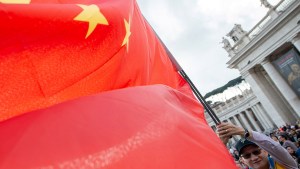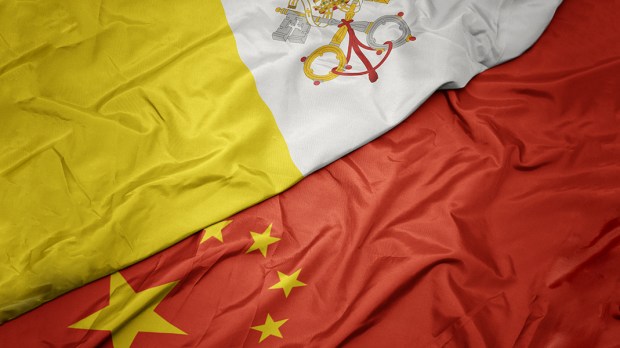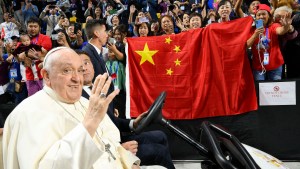Four days after the consecration of the new bishop of Zhengzhou, another episcopal consecration took place in China on January 29, 2024. The Holy See Press Office made the announcement the same day. Bishop Antonio Sun Wenjun, born in 1970 and trained in Ireland, became the first bishop of the Diocese of Weifang. This eighth appointment linked to the 2018 agreement seems to mark a sign of improvement in relations between Rome and Beijing.
The decision dates back to April 20, 2023, but was only made public on January 29, more than nine months later. Pope Francis has decided to abolish the apostolic prefecture of Yiduxian, erected by Pius XI in 1931, and to erect the new Diocese of Weifang, suffragan of Jinan, in Shandong province.
The territory of this new diocese covers the entire prefecture-city of Weifang. This northeastern Chinese metropolis covers an area of over 6,200 square miles, with a population of over 9.3 million. The small Catholic minority numbers around 6,000 members, served by ten priests and six nuns, according to the Holy See Press Office.
The first bishop of Weifang, Bishop Antonio Sun Wenjun, was ordained on January 29 “within the framework of the provisional agreement between the Holy See and the People’s Republic of China,” it states.
Born in November 1970, the new bishop studied at the Sheshan seminary in Shanghai from 1989 to 1994. He received ordination to the priesthood in Beijing in 1995, and served as a pastor in Shandong from 2005 to 2007. From 2007 to 2008, he went to Ireland to complete his training. He has been serving as a priest in Weifang since 2008.
A void of leadership in Chinese apostolic prefectures
The decision to create a diocese in its own right, even for a small community, can be understood as a desire to anchor this small Catholic reality within a stable perimeter and a specifically Chinese ecosystem, no longer linked to missionary congregations perceived by the government as carrying a risk of external interference.
Conversely, the status of “apostolic prefecture,” an ecclesiastical district that can be administered by a simple priest, is intended to be provisional. In such cases, Rome is waiting for native clergy to emerge and be able to ensure the leadership of the local Church, as has happened in Weifang
The vast majority of the Catholic Church’s apostolic prefectures worldwide are located in mainland China. Of the 39 apostolic prefectures listed in the 2023 Pontifical Yearbook, 29 were in China. However, all were officially vacant, as their leadership in the mid-20th century has generally not been replaced since the persecutions of the Maoist era and the expulsion of missionaries. The Catholic Church was nevertheless able to resume some activities with the relative easing of religious freedom restrictions from the 1970s onwards under the presidency of Deng Xiaoping, with varying degrees of freedom or clandestinity depending on the region.
Parallel Churches
The coexistence of a Church that is refractory towards the regime and the Patriotic Association of Chinese Catholics, under the tutelage of the Chinese Communist Party, has long been a source of confusion. The two communities alternate between hostility and porosity, depending on place and time. The 2018 pastoral agreement between China and the Holy See on episcopal appointments therefore aimed to establish a single hierarchy, recognized by both parties.
But this development was a painful experience for the third party concerned, the so-called “underground” or “clandestine” Church. Many of its members felt cheated by this agreement, which they see as likely to legitimize Chinese Communist Party surveillance of Catholic Church activities, or even a form of entryism.
For example, Cardinal Joseph Zen, Bishop Emeritus of Hong Kong, vehemently opposed the agreement, denouncing what he perceived as the pontifical diplomacy’s overly conciliatory attitude towards the Communist regime.
Although renewed in 2020 and 2022, the agreement has long yielded little visible fruit. In recent months, however, some episcopal appointments have unblocked the situation in certain dioceses. On January 25, Father Taddeo Wang Yuesheng was ordained bishop of Zhengzhou with the approval of Pope Francis. This was the seventh “bilateral” appointment of a bishop since China and the Holy See signed the 2018 agreement.
A “respectful confrontation” between Rome and Beijing
In July 2023, the Holy See also formally appointed Bishop Joseph Shen Bin of Shanghai, who had been transferred to this important diocese three months earlier by the Chinese authorities without Rome’s approval. When questioned by the Vatican media, Cardinal Pietro Parolin, Secretary of State of the Holy See, explained that Pope Francis had wished to “clean up the canonical irregularity that had arisen in Shanghai, for the greater good of the diocese and the fruitful exercise of the bishop’s episcopal ministry.”
Cardinal Parolin said that the Holy See intends to conduct “an open dialogue and a respectful confrontation with the Chinese side,” specifying that for “Jesus Christ to be able to ‘make himself Chinese with the Chinese,’ it’s necessary to overcome mistrust towards Catholicism, which is not a religion to be considered foreign — quite the contrary — to the culture of this great people.”
On September 3, 2023, at the end of a Mass celebrated in Mongolia in the presence of numerous pilgrims from China, Pope Francis sent a signal to the Chinese authorities, inviting Catholics in China to be “good Christians” and “good citizens.”
On September 30, the creation as cardinal of the bishop of Hong Kong, Stephen Chow, known for his diplomatic tact, was an explicit endorsement of his policy of reaching out to Beijing. In April 2023, he had visited his counterpart in the Chinese capital, Bishop Joseph Li Shan. The latter in turn visited the former British colony in November, paving the way for cooperation between the two dioceses.



